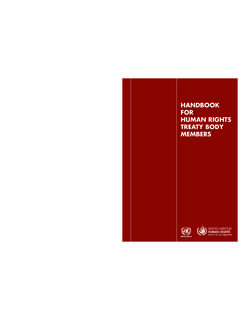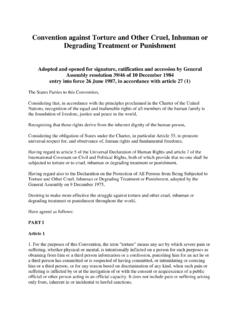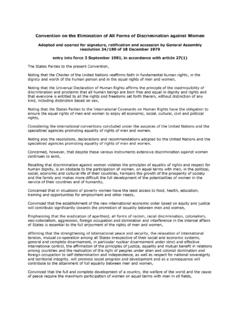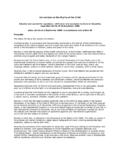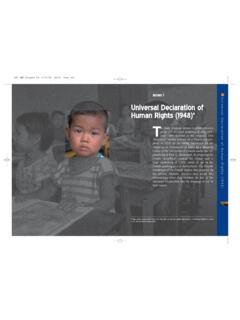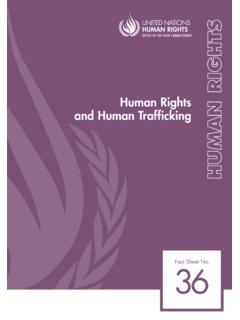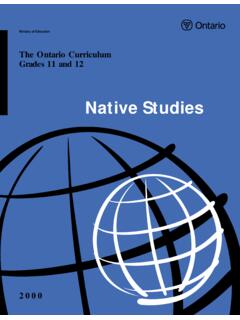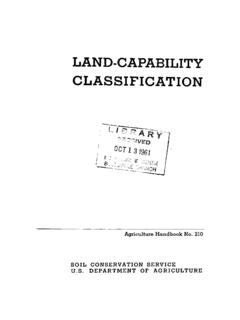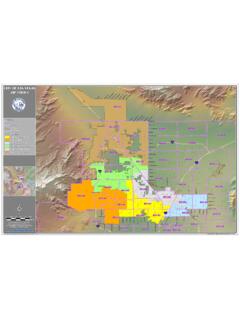Transcription of The United Nations Human Rights Treaty System
1 30 The United NationsHuman Rights Treaty SystemFact Sheet United Nations Human Rights Treaty SystemFact Sheet No. 30 Nations New York and Geneva, 2012 IINOTEThe designations employed and the presentation of the material in this pub-lication do not imply the expression of any opinion whatsoever on the part of the Secretariat of the United Nations concerning the legal status of any country, territory, city or area, or of its authorities, or concerning the delimita-tion of its frontiers or boundaries.** *Symbols of United Nations documents are composed of capital letters com-bined with figures. Mention of such a figure indicates a reference to a United Nations .
2 1 ChaptersI. DEVELOPING Human Rights STANDARDS: THE TREATIES AND THEIR OPTIONAL PROTOCOLS ..3A. Universal Declaration of Human Rights (1948) ..3B. International Convention on the Elimination of All Forms of Racial Discrimination (1965) ..5C. International Bill of Human Rights ..6D. Convention on the Elimination of All Forms of Discrimination against Women (1979) ..9E. Convention against Torture and Other Cruel, Inhuman or Degrading Treatment or Punishment (1984) ..10F. Convention on the Rights of the Child (1989) ..12G. International Convention on the Protection of the Rights of All Migrant Workers and Members of their Families (1990).
3 14H. Convention on the Rights of Persons with Disabilities (2006) ..15I. International Convention for the Protection of All Persons from Enforced Disappearance (2006) ..16J. Reading the treaties as a whole ..18II. IMPLEMENTATION OF Human Rights STANDARDS: THE Treaty BODIES ..19A. What are the Human Rights Treaty bodies? ..19B. What do the Human Rights Treaty bodies do? ..21C. Consideration of State parties reports ..21D. Consideration of complaints from individuals ..30 IVE. Inquiries ..32F. Urgent action and urgent appeals to the General Assembly under the International Convention for the Protection of All Persons from Enforced Disappearance.
4 33G. Early warning and urgent action by the Committee on the Elimination of All Forms of Racial Discrimination ..34H. Optional Protocol to the Convention against Torture and the Subcommittee on Prevention of Inter-State communications ..35J. General comments ..36K. Days of general discussion/thematic debates ..37L. Meetings of State parties and meetings with State parties ..37M. Coordination among the Treaty bodies ..37 III. DEVELOPMENT OF THE United Nations Human Rights Treaty System ..40A. The expansion of the Human Rights Treaty System and the need for strengthening it ..40B. The role and interaction of civil society and national Human Rights institutions with the Treaty body System .
5 43C. The contribution of the universal periodic review to the work of the Treaty bodies ..44D. The contribution of the special procedures to the work of the Treaty bodies ..44E. More information about the United Nations Human Rights Treaty System ..45 AnnexesII. Glossary of technical terms related to the Treaty bodies ..47II. How a State becomes a party to a Treaty ..581 INTRODUCTIONThis Fact Sheet provides a general introduction to the core international Human Rights treaties and the committees, or Treaty bodies , that monitor their implementation by State The nine core international Human Rights treaties covered in this Fact Sheet set international standards for the protection and promotion of Human Rights to which States can subscribe by becoming a party.
6 These treaties are: The International Convention on the Elimination of All Forms of Racial Discrimination; The International Covenant on Economic, Social and Cultural Rights ; The International Covenant on Civil and Political Rights ; The Convention on the Elimination of All Forms of Discrimination against Women; The Convention against Torture and Other Cruel, Inhuman or Degrading Treatment or Punishment; The Convention on the Rights of the Child; The International Convention on the Protection of the Rights of All Migrant Workers and Members of their Families; The Convention on the Rights of Persons with Disabilities; The International Convention for the Protection of All Persons from Enforced State party has an obligation to take steps to ensure that everyone in the State can enjoy the Rights set out in the Treaty .
7 The Treaty body helps them to do this by monitoring implementation and recommending further action. Although each Treaty is a separate legal instrument, which States may or may not choose to accept, and each Treaty body is a commit-tee of experts independent from the others, this Fact Sheet presents them as the United Nations Human Rights Treaty System . The extent to which the treaties and the Treaty bodies can function together as a System de-pends on two factors: first, States need to accept all the core internation-al Human Rights treaties systematically and put their provisions into opera-tion (universal and effective ratification); and, second, the Treaty bodies 1 It has become accepted to describe the committees established under the treaties as the Human Rights Treaty bodies , even though the provisions of each Treaty refer exclusively to its com-mittee.
8 It should be noted that the Committee on Economic, Social and Cultural Rights is not technically a Treaty body, since it was not established directly under the terms of the Covenant but was created by Economic and Social Council resolution 1985 to coordinate their activities so as to present a consistent and sys-tematic approach to monitoring the implementation of Human Rights at the national Office of the United Nations High Commissioner for Human Rights (OHCHR) has published specific fact sheets on most of the international treaties and Treaty bodies referred to here.
9 Those interested in a particular Treaty or Treaty body should refer to them (see list at the end). The present Fact Sheet takes a more general approach: surveying all the treaties and Treaty bodies to see to what extent they can, and do, function together as a single, holistic and integrated System for the promotion and protection of Human I presents the nine core international Human Rights treaties currently in force and their optional protocols. These treaties are the product of more than half a century of continuous elaboration since the adoption of the Uni-versal Declaration of Human Rights by the United Nations General Assembly in II presents the work of the ten2 Human Rights Treaty bodies estab-lished under the terms of these treaties.
10 These Treaty bodies monitor the implementation of the Rights set out in the treaties by the States that have ac-cepted them. The Treaty body System constitutes a key mechanism through which States are obliged to engage, at an international forum, in a rigor-ous, but constructive, dialogue on the state of Human Rights implementation in their countries. All of the Treaty bodies are considered together, concen-trating on the common elements of their mandates and working methods, but also outlining some major differences. Further details on their practical differences can be found in the specific fact III surveys the challenges facing the Human Rights Treaty sys-tem.

